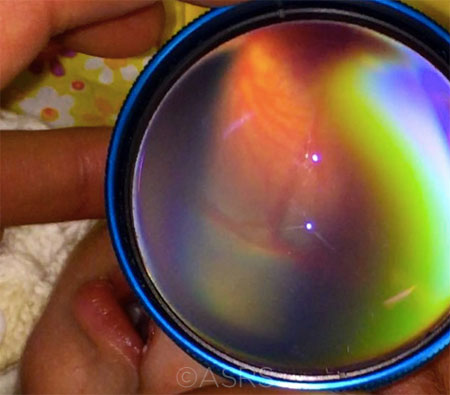Download PDF
Ophthalmologists are well aware of the need for infection control measures when performing direct-contact exams. But a recent epidemiological investigation of an adenovirus outbreak in a Pennsylvania neonatal intensive care unit (NICU) highlights the critical need for rigorous infection-control protocols even with indirect eye exams.
 |
INFECTION RISK. Adenovirus was transmitted via handheld lenses and indirect ophthalmoscopes during routine ROP screening. This image was originally published in the ASRS Retina Image Bank. Pavel Flores-Moreno. ROP. Retina Image Bank. 2018; Image Number 28554. © The American Society of Retina Specialists.
|
Adenovirus outbreak. During routine microbiologic surveillance, the Department of Infection Prevention and Control at the Children’s Hospital of Philadelphia (CHOP) discovered adenovirus-positive respiratory specimens in their NICU patients in August 2016.1 Their epidemiologic investigation included detailed review of neonates’ medical records, interviews with staff, and direct observation of clinical practices.
Connection with eye exams. Next-generation sequencing of the virus strain definitively linked the outbreak cases with ophthalmic equipment used by the providers. Real-time polymerase chain reaction (PCR) and genome sequencing found adenovirus serotype-3 DNA on 2 indirect ophthalmoscopes and 2 handheld lenses used during routine, weekly screening for retinopathy of prematurity (ROP).
Neonatal outcomes. Out of 43 neonates tested for ROP in August 2016, 23 tested positive for the adenovirus. Of these 23 cases, all had respiratory symptoms, 12 needed additional respiratory support, 5 developed pneumonia, and 11 had ocular symptoms. Four neonates died; of these, 3 had underlying serious conditions prior to infection. All 23 had received an ophthalmological exam during “ROP rounds” within 14 days of onset.
Adult outcomes. Nine adults (6 employees, 3 parents) were affected by the outbreak. All had conjunctivitis symptoms and either had provided care to or had direct contact with the infants.
Infection control. The investigation found that 2 providers, each using a handheld lens and indirect ophthalmoscope, moved bedside to bedside around the NICU, carrying their equipment by hand or in a pocket. Observation revealed a lack of standard hygiene practices, inconsistent handwashing, and limited glove use with this shared equipment.
The NICU then instituted stricter infection control protocols, including isolation, heightened vigilance of hand hygiene and use of gloves, daily staff screening for symptoms, and environmental disinfection. The NICU was able to contain the outbreak; no secondary transmission occurred with this vulnerable, high-risk population.
Looking ahead. As the outbreak has triggered legal action, CHOP officials declined to comment. But Kimberly A. Drenser, MD, PhD, at Beaumont Eye Institute in Royal Oak, Michigan, pointed out, “For premature infants, the risk of exposure is high, since they receive eye exams weekly and the ophthalmologists aren’t regular NICU staff. It’s much harder to control infection with outside staff coming in to do bedside exams.”
As a result, Dr. Drenser added, “more NICUs are moving toward digital teleophthalmology exams for ROP. NICU staff take infants’ photos and an outside reader evaluates them.”
—Rebecca Taylor
___________________________
1 Sammons JS et al. Ophthalmology. Published online Sept. 1, 2018.
___________________________
Relevant financial disclosures—Dr. Drenser: None.
For full disclosures and the disclosure key, see below.
Full Financial Disclosures
Dr. Chen U.S. Department of Defense: S; Harvard Foundation Grant (Fidelity Charitable Fund): S.
Dr. Drenser Interview Medical Systems: O,P; Phoenix: O; Retinal Solutions: O,P; Spark Therapeutics: C.
Prof. Dua Croma: C; Dompé: C; GlaxoSmithKline: O; NuVision Biotherapeutic: O; Santen: C; Shire: C; Thea: C; VisuFarma: C.
Dr. Kelly U.S. Department of Defense: S; Neuro Kinetics: S.
Disclosure Category
|
Code
|
Description
|
| Consultant/Advisor |
C |
Consultant fee, paid advisory boards, or fees for attending a meeting. |
| Employee |
E |
Employed by a commercial company. |
| Speakers bureau |
L |
Lecture fees or honoraria, travel fees or reimbursements when speaking at the invitation of a commercial company. |
| Equity owner |
O |
Equity ownership/stock options in publicly or privately traded firms, excluding mutual funds. |
| Patents/Royalty |
P |
Patents and/or royalties for intellectual property. |
| Grant support |
S |
Grant support or other financial support to the investigator from all sources, including research support from government agencies (e.g., NIH), foundations, device manufacturers, and/or pharmaceutical companies. |
|
More from this month’s News in Review